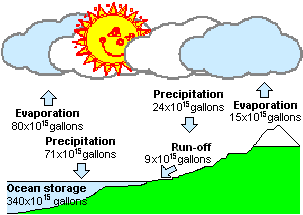Earth and its Neighbors

Updated on
05/05/2015
|
Earth and its Neighbors |
 |
||||
| Home My Book Physical Geology Environmental Geology Oceanography |
|
|
|||
|
Updated on |
|||||
|
Earth and the other terrestrial or earth-like
planets (Mercury, Venus, Mars, Asteroids and perhaps Pluto) are the Solar
system's smaller but heavier planets. They are called 'rocky' because of the
abundance of silica (the common constituent of most of earth's minerals and
rocks) in their composition. As the following graph of abundance of different elements shows, hydrogen and oxygen are available aplenty over the entire solar system. |
||||||||||||||||||||||||||||||||||||||||||||||||||||||||||||||||||||||||||||||||||||||||||||
|
|
|
Compositionally, three groups of elements form the major constituents of Solar System:
|
|
|||||||||||||||||||
|
||||||||||||||||||||
|
Two reasons explain why water, which should occur all over the Solar System wherever the temperatures are between 0ºC and 100ºC, is so abundant on the Earth but a rarity elsewhere: |
|
||||||
 |
Of these, hydrological cycle is the continuous recycling of water between oceans, atmosphere and land. As the run-off from land would eventually fill up the ocean basins and level the land, hydrological cycle carries the seeds of its own destruction because the resulting smoothening of the surface eventually translates into the drying up of the Earth. |
||||||
|
Browse these sites to learn about the |
|||||||
|
hydrological cycle: |
6 |
||||||
|
|||||||
| Plate tectonics, on the other hand, involves the creation of new surface area, in the form of ocean basins, so compensating for the surface area lost in folded mountain belts and deep sea trenches. This explains why the ocean floor is made up of basalt, a volcanic rock, and ascribes the changing geography of land and oceans over geological time, seen in these images on the right for the past 250 Ma for instance, to relative angular motions of the lithospheric plates (lithosphere is the earth's rigid outermost shell). |
|
Not surprisingly, therefore, the boundaries of these plates are essentially characterized by seismicity or earthquake activity. |
|
|||||||
|
Visit these sites to learn more about plate tectonics: |
► |
|
Obviously, the water on Earth would have long disappeared had plate tectonics not existed to continually create the ocean basins that hydrological cycle would then fill up. Earth remains the water planet because
|
|||||||||||